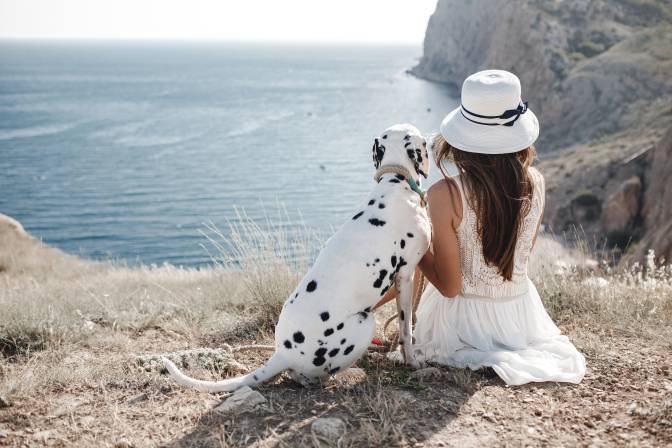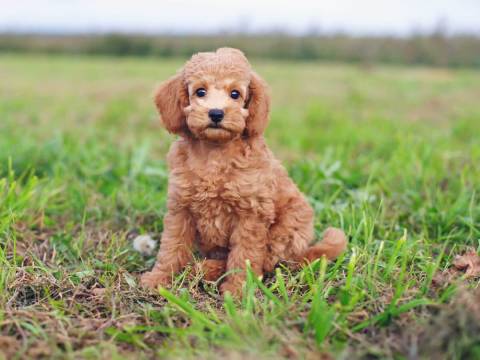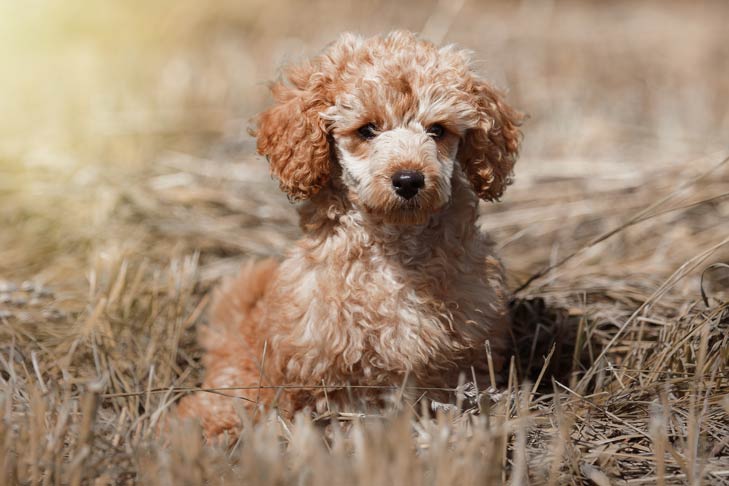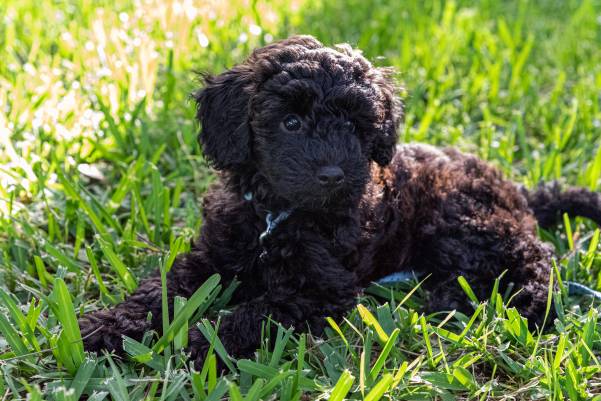Connect with a verified veterinarian in minutes. Licensed vets are available 24/7 to answer your questions. No need to worry about your furry family member.
We write about some unique dog breeds on our site, and we’ve come across another dog breed you may not be familiar with! Have you ever heard of the Dalmadooble dog breed? If not, you’re in good company!
In this article, we’ve put together some information about Dalmadoodles. If you’re looking for a unique dog to adopt, this one may be right for you! Read on to learn if this dog breed could be right for you and your family!
What is a Dalmadoodle?
The Dalmadoodle is a hybrid dog breed, which is why you may not have heard about these amazing dogs. They’re the result of crossing two purebred dogs—the Poodle and the Dalmatian!
Being hybrids, Dalmadoodles tend to resemble either their Dalmatian or Poodle parents. These dogs usually don’t have the blended look of both parents. You may hear Dalmadoodles also referred to as Dalmapoos, Dalmatiandoodles, and Dalmatianpoos.
However, Dalmadoodles are usually black and white spotted, with fur that is somewhat like a Poodle’s. Like their parents, the dogs are highly intelligent, loyal, and affectionate. They make wonderful family companions.
No one is sure when Dalmadoodles were first developed or much about their history. However, we can take a look at the parents to get some idea about the unique dog breed!
Poodles are sometimes thought of as fancy dogs with unique hairstyles! That’s soccasionallytrue; however, these dogs were originally bred to hunt and retrieve waterfowl. Poodles usually have long legs, long muzzles, and dropped ears. They are beautiful, athletic dogs!
Poodles are famous for their curly hair, which requires regular grooming and brushing. They’re highly intelligent dogs that are easy to train. They also have a ton of energy and love to have fun!
Many people don’t realize Poodles were actually developed in Germany rather than France! The word “Poodle” comes from the German word “pudel,” which means “to splash in the water.” In France, the dogs are called “Caniche,” which is French for “duck dog!”
The Dalmadoodle’s other parent is the Dalmatian. These dogs are famous for their black and white coats. They’ve appeared in many Disney movies and cartoons, TV shows, and more! The dogs are thought to have traveled with bands of Romani people, and it’s not clear when the dogs were first developed or where. However, while in Dalmatia (today’s Croatia), the dogs became known as Dalmatians.
Dalmatians have been used for various jobs over the course of their long history. They’ve been used as guard dogs, shepherds, ratters, retrievers, circus performers, and even coaching dogs. In England, the dogs were used to run alongside the coat and guard the horses and coach when they were stopped.
Needless to say, Dalmatians have a ton of energy! The dogs are highly intelligent and need training and socializing from a young age. These dogs can be a bit stubborn and challenging to train. However, the dogs do excel at dog sports, games, and agility competitions. The dogs love to hike, jog, and more!
So, these are the parents of the Dalmadoodle!
Dalmadoodles usually stand between 20-24 inches tall and weigh between 40 to 70 lbs. They have a life expectancy between 11 to 14 years.
Dalamadoodle Appearance
The Dalmadoodle usually resembles either the Dalmatian or the Poodle parent in physical appearance. These dogs tend to have an athletic build.
Their fur is can vary between a short coat and a long curly coat. And the dogs are usually white with black spots. However, some of these dogs may only have spots on one part of the body.

Review symptoms, medications & behavior to keep your pets healthy with a Vet Online in just minutes.
Ask a Vet Live NowDalmadoodle Temperament
Dalmadoodles are highly intelligent dogs. Remember, both of their parents are also highly intelligent. The Dalmadoodle can quickly learn almost anything they’re taught. However, they can also be quite the escape artist. They can easily find their way out of a yard. For this reason,n the dogs require a dog-proof fenced yard to play in.
The dogs are usually stubborn like their Dalmatian parent, making them challenging to train. These dogs do best with experienced pet parents who understand how to be firm and use positive reinforcement training methods. What’s more, these dogs need consistent training!
Dalmadoodles are also quite affectionate and rarely aggressive. However, they do have a tendency to guard and protect. And the dogs need plenty of exercise each day to help them burn off excess energy and provide them with the mental stimulation needed for a healthy dog. You don’t want a bored Dalmadoodle! We promise you won’t like coming home to chewed up shoes and furniture!
Do Dalmadoodles Make Good Family Companions?
Yes! They do make great family companions, and they’re great with kids. However, these dogs can also be quite protective of their humans and wary of strangers.
Do Dalmadoodles Get Along with Other Dogs & Pets?
Most Dalmadoodles get along well with other dogs. However, they have inherited a strong prey drive from their Poodle parent. So, they could go after cats and other small pets.
However, with proper training and socialization, these dogs can learn to get along with cats and small animals.
Health Issues
Dalmadoodles can suffer from a wide range of health issues, including:
- Ear infections
- Skin allergies
- Eye issues
- Hip dysplasia
- Deafness
- Addison’s disease
- Bloat
- Cushing’s disease
- Urinary stones
- Epilepsy
Diet
Dalmadoodles do best on kibble that’s high-quality and specially formulated for active dogs. They need about 1 ½ to 3 cups of food a day, divided between two meals.
Exercise Requirements
Dalmadoodles usually take after their Poodle parent and need a moderate amount of exercise each day. These dogs love to walk, play, and run in the dog park.
However, some Dalmadoodles may require more exercise, similar to their Dalmatian parent. They love to run, hike, and walk!
Grooming
The Dalmadoodle may have short, fine hair like their Dalmatian parent. If so, the coat needs to be brushed daily to keep it clean and free of mats. These dogs may shed more, too.
If your fur baby is more like a Poodle, they may need to see a groomer on a regular basis. Thankfully, dogs with Poodle-like hair don’t shed as much.
Summing It Up
So, there you have it! The Dalmadoodle is a highly intelligent, beautiful dog that can take after their Poodle or Dalmatian parent. What’s more, these dogs make great companions for active families.
If you choose to adopt a Dalmadoodle, we’re pretty sure you’ll have a beautiful, affectionate, fun-loving fur baby for many years to come!
Connect with a verified veterinarian in minutes. Licensed vets are available 24/7 to answer your questions. No need to worry about your furry family member.

Julie
Julie is a graduate of the University of North Carolina, Wilmington, where she studied Animal science. Though contrary to the opinion of her parents she was meant to study pharmacy, but she was in love with animals especially cats. Julie currently works in an animal research institute (NGO) in California and loves spending quality time with her little cat. She has the passion for making research about animals, how they survive, their way of life among others and publishes it. Julie is also happily married with two kids.
Review symptoms, medications & behavior to keep your pets healthy with a Vet Online in just minutes.
Ask a Vet Live Now




